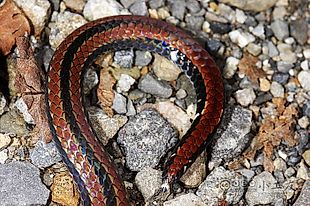Sinomicrurus sauteri
Taiwan Coral Snake
梭 德氏帶紋赤蛇 (suo1de2shi4dai4wen2chi4she2)
Status: Protected (Cat.II)
HIGHLY VENOMOUS!
Family
Elapidae, subfamily Elapinae
Max. length
98 cm
Occurrence in Taiwan
South and central Taiwan, at altitudes of 500-1500 m. Very rare.
Global Distribution
Endemic to Taiwan.
Description
Small snake; total length is up to 98 cm. It has 13-15 rows of scales, which are smooth, glossy, and irridescent. Head is broadly rectangular to square and not distinct from neck; body is slim, round; tail is short and ends in a strongly chitinized, rigid tip. Eye is medium-sized; iris is dark gray to black and indistinct since it blends in with dark color of head; pupil is round, black. There are no loreals. Tongue is dull red to flesh-colored, with diffuse gray fork tips. Fangs are small and in anterior part of upper jaw. Upper head is dark brown to black, mottled with light brown in forehead; there is a broad cream or white band across head behind eyes. The supralabials are intermittently white, black, or mottled. Upper body is dark brown, crimson, and distinctly marked with three black longitudinal stripes from neck to tip of tail; the mid-dorsal stripe is narrower than the lateral ones. Ventral head and neck are white to dirty white, sometimes mottled with black. The infralabials bear distinct lines of black pigment at junction of anterior-most scales. Ventral body and tail are white to dirty white, with irregular size and irregularly distributed spots or cross bands of black. Anal scale is divided and subcaudals are paired.
Biology & Ecology
Sinomicrurus is a genus of venomous elapids known as Oriental or
Eastern Coral Snakes, three of which are endemic to Taiwan:
S. hatori, S. sauteri and S. macclellandi.
The oviparous Taiwan Coral Snake is cathemeral (diurnal or nocturnal)
and lives on montane forest floors, in stone cracks and among decayed
plant matter. It is not aggressive, and very few reports of bites
by this snake have been recorded, but its venom contains strong neurotoxins
which can be life-threatening. Little is known about its biology and ecology,
but lizards and small snakes may be its staple foods.
Many field guides and standard works tend to dismiss the smaller elapids as of
little concern. However, the complex nature of the venoms of these small snakes,
and higher venom yields than anticipated, underscores the fundamental consideration
that even lesser-known, small species may still be capable of clinically significant
envenomings after exceptional bites in which a larger than usual quantity of venom is
injected. Lethal evenomations have already occurred with other small elapids thought
to be harmless, such as the tragic death of Hans Schnurrenberger by a 30 cm
Sinomicrurus macclellandi; the initial bite was ignored until neurotoxic symptoms
showed up 6 hours later, and death was 8 hours after envenomation. (B. G. Fry et al., 2003).
Etymology
Sinomicrurus is a compound word assembled from Sino, New Latin for "Chinese",
and the Greek words mikros = small, and ura = tail; alluding to the short, pointy tails of this genus;
sauteri: in honor of Hans Sauter, a Taiwan-based German entomologist who collected the type specimen for A. sauteri.
The Chinese name 梭德氏帶紋赤蛇 (suo1de2shi4dai4wen2chi4she2) means "Sauter's (梭德氏) Striped (帶紋) Red Snake (赤蛇)".
Notes
Sinomicrurus hatori and S. sauteri may look very similar at first glance. The main morphological distinction
between the two are the white spots along the sides of S. hatori.
However, the validity of this species is questionable. Slowinski et al. (2001, see below) found no differences
on morphological data (of skull, hemipenes, venoms, etc.) between it and S. sauteri; the numbers of ventrals
in these two species may overlap (according to data from Ota et al., 1999). In addition, individuals of this
species with less distinct black bars along the mid-dorsal stripe have been found.
Further Info
- Reptile Database
- Coral Snakes
- Higher-level phylogeny of Asian and American coralsnakes, their placement within the Elapidae (Squamata), and the systematic affinities of the enigmatic Asian coralsnake Hemibungarus calligaster (Wiegmann, 1834)
In The phylogenetic relationships of Asian coral snakes (Elapidae: Calliophis and Maticora) based on morphological and molecular characters (Herpetologica 57: 233-245), Slowinski, J.B., J. Boundy & R. Lawson"analysed the phylogeny of oriental coral snakes (together with New World coral snakes) by means of both morphological characters and mitochondrial DNA sequences. The generic classification of these snakes has been subject to confusion and controversy for some time, with some species being assigned to the genus Hemibungarus, but without much robust evidence (see comments on Elapidae 1999 page). The present study identified three main evolutionary groupings within Oriental coral snakes, which the authors recognise as distinct genera:(i) Calliophis, a tropical Asian genus including the species C. beddomei, C. bibroni, C. gracilis, C. maculiceps, C. melanurus, C. nigrescens, C. intestinalis and C. bivirgatus. Note that Maticora is treated as a synonym of Calliophis.(ii) Hemibungarus, which contains the single Philippine species H. calligaster.(iii) Sinomicrurus, a new genus, which contains a series of subtropical species: S. hatori, S. japonicus, S. kelloggi, S. macclellandi and S. sauteri. Both molecular and morphological studies support the hypothesis that this assemblage constitutes the sister group to the New World coral snakes."(Source)

















